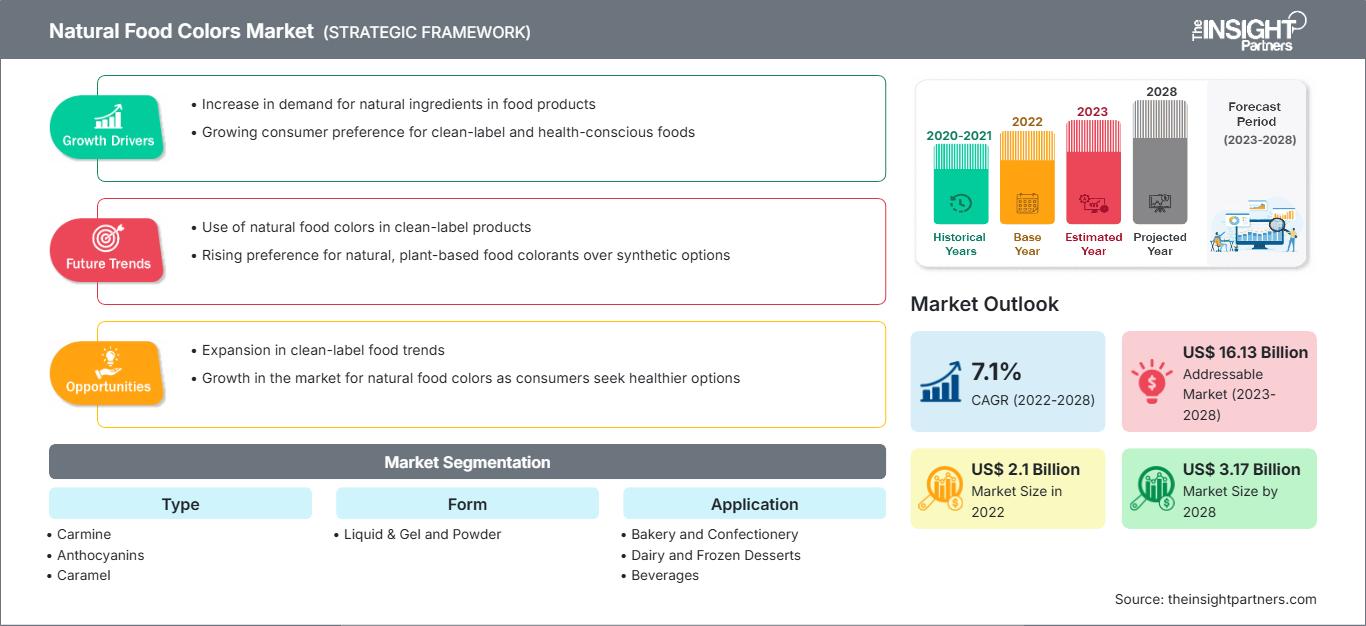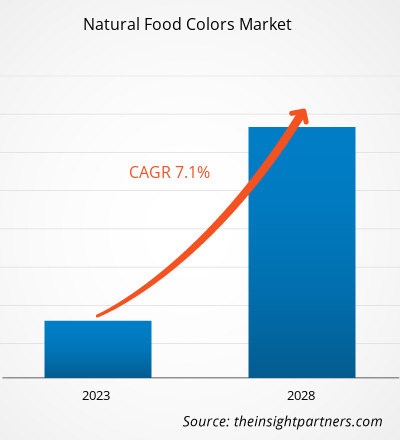[Forschungsbericht]Der Markt für natürliche Lebensmittelfarben soll von 2,10 Milliarden US-Dollar im Jahr 2022 auf 3,17 Milliarden US-Dollar im Jahr 2028 anwachsen. Für den Zeitraum 2022–2028 wird ein durchschnittliches jährliches Wachstum von 7,1 % erwartet.
Die Nachfrage nach natürlichen Lebensmittelfarben steigt aufgrund des zunehmenden Bewusstseins der Verbraucher für die schädlichen Auswirkungen synthetischer Farbstoffe und der zunehmenden gesetzlichen Vorschriften und Bestimmungen zur Verwendung synthetischer Farbstoffe. Die meisten Menschen achten heutzutage auf ihre Gesundheit und entscheiden sich für Bio- und Naturprodukte. Natürliche Lebensmittelfarben sind unbedenklich und steigern den Nährwert von Lebensmitteln. Darüber hinaus enthalten natürliche Lebensmittelfarben keine üblichen allergieauslösenden Inhaltsstoffe. Stattdessen enthalten sie Antioxidantien, die das Risiko vieler Krankheiten senken. All diese Faktoren treiben den Markt an.
Dank der starken Präsenz namhafter Akteure wie Koninklijke DSM NV, Sensient Technologies und Archer Daniels Midland Company wird für den Markt in den kommenden Jahren ein deutliches Wachstum prognostiziert. Eine große Vielfalt an natürlichen Lebensmittelfarben hat die Aufmerksamkeit der Verbraucher auf sich gezogen. Es gibt einen wachsenden Trend zum Konsum verpackter RTE- und RTC-Lebensmittelprodukte. Dieser Faktor wird den Herstellern natürlicher Lebensmittelfarben im Prognosezeitraum voraussichtlich neue Möglichkeiten bieten.
Im Jahr 2021 hielt Europa den größten Anteil am globalen Markt für natürliche Lebensmittelfarben. Der asiatisch-pazifische Raum wird im Prognosezeitraum jedoch voraussichtlich die höchste durchschnittliche jährliche Wachstumsrate (CAGR) auf dem Markt verzeichnen. Der asiatisch-pazifische Markt ist in China, Indien, Australien, Japan, Südkorea und den Rest des asiatisch-pazifischen Raums segmentiert. Die Lebensmittel- und Getränkeindustrie ist aufgrund der wachsenden Bevölkerung und der veränderten Essgewohnheiten der Verbraucher eine der boomenden Branchen im asiatisch-pazifischen Raum. Verbraucher in Entwicklungsländern erleben einen starken Anstieg ihres verfügbaren Einkommens und damit eine steigende Kaufkraft. Der Anstieg des verfügbaren Einkommens der Verbraucher und das Wachstum der Mittelschicht zählen zu den wichtigsten Faktoren, die den Markt für natürliche Lebensmittelfarben in der Region antreiben.
Passen Sie diesen Bericht Ihren Anforderungen an
Sie erhalten kostenlos Anpassungen an jedem Bericht, einschließlich Teilen dieses Berichts oder einer Analyse auf Länderebene, eines Excel-Datenpakets sowie tolle Angebote und Rabatte für Start-ups und Universitäten.
Markt für natürliche Lebensmittelfarben: Strategische Einblicke

-
Holen Sie sich die wichtigsten Markttrends aus diesem Bericht.Dieses KOSTENLOSE Beispiel umfasst Datenanalysen, die von Markttrends bis hin zu Schätzungen und Prognosen reichen.
Auswirkungen der COVID-19-Pandemie auf den Markt für natürliche Lebensmittelfarben
Vor der COVID-19-Pandemie wurde das Wachstum des Marktes für natürliche Lebensmittelfarben hauptsächlich durch die steigende Nachfrage nach biologischen und natürlichen Lebensmitteln mit hohem Nährwert vorangetrieben. Im ersten Quartal 2020 war der Markt jedoch aufgrund von Geschäftsschließungen sowie Rohstoff- und Arbeitskräftemangel mit Hürden konfrontiert. Die COVID-19-Pandemie führte in den ersten Monaten des Jahres 2020 zu einer Wirtschaftsrezession, die Verbraucher mit niedrigem und mittlerem Einkommen in finanzielle Schwierigkeiten brachte.
Darüber hinaus blieben die Menschen aufgrund der Einschränkungen zu Hause und kochten zu Hause, wodurch eine Nachfrage nach abgepackten Lebensmitteln entstand, die leicht zuzubereiten sind. Dies ließ die Nachfrage nach verzehrfertigen und rezeptfreien Lebensmitteln sprunghaft ansteigen, was zu einem Wachstum des Marktes für natürliche Lebensmittelfarben führte. Die Verbraucher wurden zudem gesundheitsbewusster und bevorzugten Lebensmittelprodukte, die natürlich und sicherer zu konsumieren sind. Dies trieb das Marktwachstum während der COVID-19-Pandemie voran.
Markteinblicke
Steigende Vorliebe der Verbraucher für Clean-Label-Produkte
Viele Menschen glauben, dass Lebensmittel und Getränke nur dann gesünder sind, wenn sie ein Etikett mit erkennbaren Zutaten haben. Die Lebensmittel- und Getränkeindustrie ist in eine Phase der Clean-Label-Produkte eingetreten, was Hersteller dazu veranlasst, natürliche Lebensmittelfarben zu verwenden, um sich einen Wettbewerbsvorteil zu verschaffen. Clean-Label-Produkte ziehen auch mehr Kunden an, da Verbraucher Produkte mit bekannten Zutaten lieber konsumieren.
Die Vorliebe der Verbraucher für Clean-Label-Produkte steigt aufgrund des steigenden Gesundheitsbewusstseins und der zunehmenden Lebensmittelverfälschung. Dies führt dazu, dass Verbraucher vor dem Kauf von Produkten auf die Etiketten achten. Dieser Faktor dürfte ein entscheidender Treiber für den Markt für natürliche Lebensmittelfarben sein.
Kategorie-Einblicke
Basierend auf dem Produkttyp ist der globale Markt für natürliche Lebensmittelfarben in Karmin, Anthocyane, Karamell, Curcumin, Annatto, Carotinoide, Chlorophyll und andere unterteilt. Im Jahr 2021 machte das Segment der Carotinoide den größten Umsatzanteil aus, und das Segment der Anthocyane dürfte im Prognosezeitraum die höchste Wachstumsrate aufweisen. Natürliche Lebensmittelfarben werden aus Pflanzen, Tieren und anderen organischen Materialien gewonnen. Sie sind sicher zu verzehren, da sie keine allergieauslösenden Inhaltsstoffe enthalten.
Zu den Akteuren auf dem Markt gehören Koninklijke DSM NV, Sensient Technologies, Archer Daniels Midland Company, Döhler Group, BASF SE, Naturex SA, Aromata Group, Givaudan, Dupont, Oterra A/S und Mane KANCOR. Diese Unternehmen bieten dem Markt ein breites Produktportfolio. Sie sind in Entwicklungsregionen präsent und bieten lukrative Marktchancen. Die Marktteilnehmer entwickeln hochwertige, innovative Produkte, um die Kundenanforderungen zu erfüllen.
Natürliche Lebensmittelfarben
Regionale Einblicke in den Markt für natürliche LebensmittelfarbenDie Analysten von The Insight Partners haben die regionalen Trends und Faktoren, die den Markt für natürliche Lebensmittelfarben im Prognosezeitraum beeinflussen, ausführlich erläutert. In diesem Abschnitt werden auch die Marktsegmente und die geografische Lage für natürliche Lebensmittelfarben in Nordamerika, Europa, dem asiatisch-pazifischen Raum, dem Nahen Osten und Afrika sowie Süd- und Mittelamerika erörtert.
Umfang des Marktberichts über natürliche Lebensmittelfarben
| Berichtsattribut | Einzelheiten |
|---|---|
| Marktgröße in 2022 | US$ 2.1 Billion |
| Marktgröße nach 2028 | US$ 3.17 Billion |
| Globale CAGR (2022 - 2028) | 7.1% |
| Historische Daten | 2020-2021 |
| Prognosezeitraum | 2023-2028 |
| Abgedeckte Segmente |
By Typ
|
| Abgedeckte Regionen und Länder |
Nordamerika
|
| Marktführer und wichtige Unternehmensprofile |
|
Dichte der Marktteilnehmer für natürliche Lebensmittelfarben: Verständnis ihrer Auswirkungen auf die Geschäftsdynamik
Der Markt für natürliche Lebensmittelfarben wächst rasant. Die steigende Nachfrage der Endverbraucher ist auf Faktoren wie veränderte Verbraucherpräferenzen, technologische Fortschritte und ein stärkeres Bewusstsein für die Produktvorteile zurückzuführen. Mit der steigenden Nachfrage erweitern Unternehmen ihr Angebot, entwickeln Innovationen, um den Bedürfnissen der Verbraucher gerecht zu werden, und nutzen neue Trends, was das Marktwachstum weiter ankurbelt.

- Holen Sie sich die Markt für natürliche Lebensmittelfarben Übersicht der wichtigsten Akteure
Bericht-Spotlights
- Fortschreitende Branchentrends auf dem Markt, die den Akteuren bei der Entwicklung effektiver langfristiger Strategien helfen
- Geschäftswachstumsstrategien in entwickelten und sich entwickelnden Märkten
- Quantitative Analyse der Marktgröße für natürliche Lebensmittelfarben von 2020 bis 2028
- Schätzung der globalen Marktnachfrage nach natürlichen Lebensmittelfarben
- PEST-Analyse zur Veranschaulichung der Wirksamkeit von Käufern und Lieferanten in der Branche
- Jüngste Entwicklungen zum Verständnis des wettbewerbsorientierten Marktszenarios
- Markttrends und -aussichten sowie Faktoren, die das Wachstum des Marktes für natürliche Lebensmittelfarben vorantreiben und hemmen
- Unterstützung im Entscheidungsprozess durch Hervorhebung von Marktstrategien, die das kommerzielle Interesse untermauern und zum Marktwachstum führen
- Die Größe des Marktes für natürliche Lebensmittelfarben an verschiedenen Knotenpunkten
- Detaillierte Übersicht und Segmentierung des Marktes sowie die Dynamik der Branche für natürliche Lebensmittelfarben
- Marktgröße für natürliche Lebensmittelfarben in verschiedene Regionen mit vielversprechenden Wachstumschancen
Die „Marktanalyse für natürliche Lebensmittelfarben bis 2028“ ist eine spezialisierte und gründliche Studie der Konsumgüterindustrie mit besonderem Augenmerk auf der globalen Trendanalyse des Marktes für natürliche Lebensmittelfarben. Der Bericht soll einen Marktüberblick mit detaillierter Marktsegmentierung bieten.
Der Markt für natürliche Lebensmittelfarben wird nach Typ, Form, Anwendung und Geografie analysiert. Nach Typ ist der globale Markt für natürliche Lebensmittelfarben in Karmin, Anthocyane, Karamell, Kurkumin, Annatto, Carotinoide, Chlorophyll und weitere unterteilt. Nach Form ist der globale Markt für natürliche Lebensmittelfarben in Flüssigkeiten, Gele und Pulver unterteilt. Nach Anwendung ist der globale Markt für natürliche Lebensmittelfarben in Back- und Süßwaren, Milchprodukte und Tiefkühldesserts, Getränke, Soßen, Dressings und Gewürze, RTC- und RTE-Produkte, Fleisch, Geflügel, Meeresfrüchte und weitere unterteilt. Geografisch ist der Markt grob in Nordamerika, Europa, Asien-Pazifik (APAC), den Nahen Osten und Afrika (MEA) sowie Süd- und Mittelamerika unterteilt.
Unternehmensprofile
Koninklijke DSM NV, Sensient Technologies, Archer Daniels Midland Company, Döhler Group, BASF SE, Naturex SA, Aromata Group, Givaudan, Dupont, Oterra A/S und Mane KANCOR gehören zu den führenden Akteuren auf dem globalen Markt für natürliche Lebensmittelfarben.
- Historische Analyse (2 Jahre), Basisjahr, Prognose (7 Jahre) mit CAGR
- PEST- und SWOT-Analyse
- Marktgröße Wert/Volumen – Global, Regional, Land
- Branchen- und Wettbewerbslandschaft
- Excel-Datensatz
Aktuelle Berichte
Verwandte Berichte
Erfahrungsberichte
Grund zum Kauf
- Fundierte Entscheidungsfindung
- Marktdynamik verstehen
- Wettbewerbsanalyse
- Kundeneinblicke
- Marktprognosen
- Risikominimierung
- Strategische Planung
- Investitionsbegründung
- Identifizierung neuer Märkte
- Verbesserung von Marketingstrategien
- Steigerung der Betriebseffizienz
- Anpassung an regulatorische Trends






















 Kostenlose Probe anfordern für - Markt für natürliche Lebensmittelfarben
Kostenlose Probe anfordern für - Markt für natürliche Lebensmittelfarben